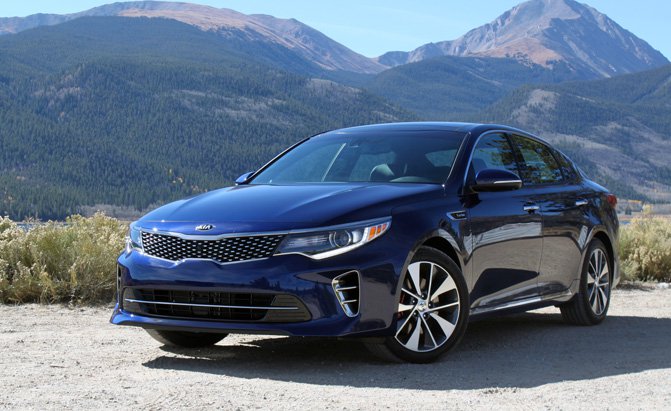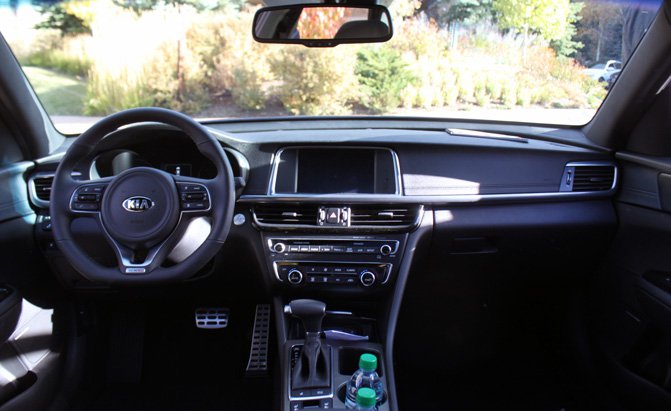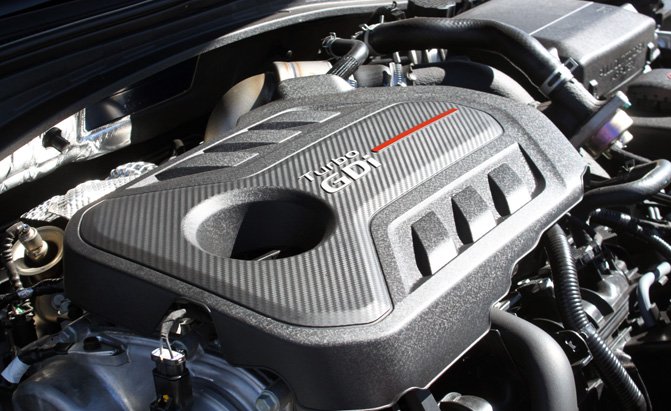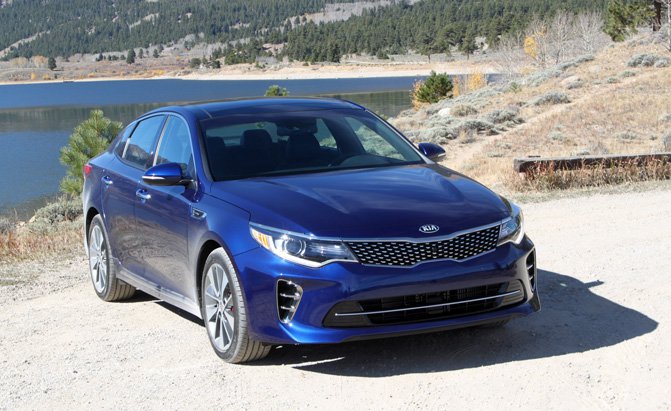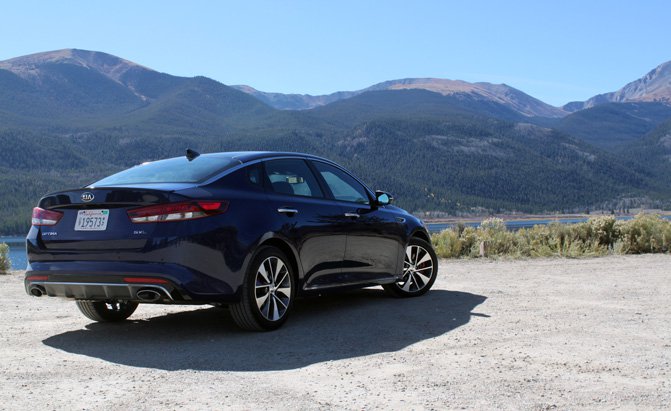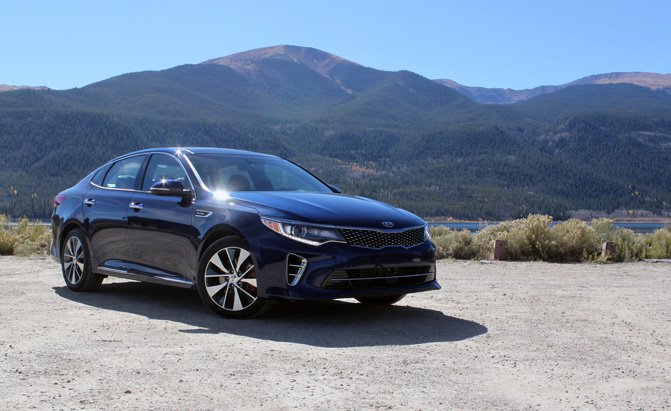All new for 2016 (even if it doesn’t look it), the Kia Optima is a big deal for the Korean company. It was the automaker’s best seller for three consecutive years and was the first car from Kia to break the 150,000 units sold mark.
To make a radical change to its mid-size sedan now would upset the momentum that Kia has built up to this point. So instead of introducing a completely new looking Optima, the company gave the car some lessons in the more refined things in life, giving the car more useable torque, fancy features and a quiet demeanor.
Same Great Design
It may be hard to really differentiate the new Optima from the outgoing model, but that’s just fine. The last generation mid-size sedan had a distinct style that was modern and sporty and the new gen Kia continues with this momentum.
It has grown slightly in all directions; the Optima is taller, wider and longer. The size difference is so subtle, I have no doubt Blake Griffin could still dunk over it.
Kia’s designers definitely showed a sense of restraint, making sure the car still looked respectable rather than overdone with larger grilles, excessive chrome and other tacky add-ons. For example, the roofline is accented by a tasteful chrome strip that runs all the way to the trunk. Around back, a pair of oval exhaust tips stick out from a sporty carbon-fiber looking diffuser. The Optima also is available with slick looking LED tail lights and also offers a great looking headlight design with LED daytime running lights that give the car an easily identifiable light profile. The only questionable exterior design element is the Turbo badges found on the front fender, which seem a bit unnecessary.
Boring Interior
As slick as the exterior is, the interior isn’t as tastefully done. It looks acceptable, and fit and finish is excellent, but the some materials leave obvious room for improvement. One painful point is the glossy soft touch material found on top of the dashboard, which shimmers in sunlight and can blind the driver and passenger, or create a glare in the windshield.
However, kudos to Kia for the fantastic seats found in the Optima. They’re soft, comfortable and supportive. You sink right in and will not want to leave them. They look even better in higher trim levels, with that oh-so-cool diamond stitched pattern in the leather. These higher end models also come with heated and cooled features. The rear seats are equally accommodating with a ton of leg room and are optionally heated. Cargo space has improved by 0.5 cubic feet to a total of 15.9 cubic feet.
The UVO infotainment system arrives standard with Android Auto, and is responsive, bright and easy to use. Less impressive is the gauge cluster, which feels plucked right out of any other from the past year, which is to say it’s a bit bland.
Refined, Less Powerful Powertrains
Under the hood, you’ll find some familiar faces that have received a slight makeover. A 2.4-liter four-cylinder engine is found in base models making 185 hp and 178 lb-ft of torque. A 2.0-liter turbo-four was the only powertrain available for testing, a mill that makes 245 hp and 260 lb-ft of torque. New for this generation is a 1.6-liter turbo that makes 178 hp and 195 lb-ft of torque. Kia may not be making big splashes with the horsepower numbers of its engines, but the torque figures are impressive. Peak torque in the turbocharged engines arrives at under 2,000 rpm, while the naturally aspirated unit peaks at 4,000 rpm.
ALSO SEE: 2016 Honda Accord Review
Interestingly enough, the 2.4 and 2.0-turbo engines that were available in the last Optima made more horsepower. However in testing, the new 2.0-turbo feels remarkably smooth and was sufficient for making passes on the highway. If anything, Kia took out some of the rowdiness out of the engine, and the result is a very composed, smooth and well-behaved motor.
The 2.4 and 2.0-turbo use six-speed automatic transmissions, while the 1.6-turbo uses a new seven speed dual clutch transmission. The six-speed is smooth in the bigger turbo model, and in higher trim models, drivers can choose their gear via paddle shifters. Also available is a drive mode selector, which modifies the transmission shift logic and steering effort to deliver a sportier drive in Sport mode, or more fuel efficient one in Eco mode.
Driving Dynamics
Like its exterior design and powertrains, the 2016 Kia Optima is so refined on the road. It’s comfortable and direct without the twitchiness and stiffness of other sport-tuned sedans. Around the canyons and mountain passes of Aspen, Colorado, the car was entertaining enough, but skewed more towards comfortable.
The turbocharged 2.0-liter engine didn’t feel wheezy in the higher altitudes, and pushed the Optima through the corners and twisty roads. On the road, the car doesn’t feel large, as its longer proportions would indicate.
ALSO SEE: 2015 Hyundai Genesis vs 2016 Nissan Maxima
A number of driver assists are available, including adaptive cruise control and a forward collision avoidance technology. Thanks to the safety feature, the adaptive cruise control can bring the Optima to a complete stop, making it a killer feature when you’re stuck in traffic. Other features like blind spot assist, lane departure warning and a very useful 360-degree camera for parking are all available as well.
The biggest stand out feature of the Optima is how quiet it is. Closing the windows and turning off the fantastic 630-watt harmon/kardon stereo, had the cabin so serene that my passenger and I started whispering to each other. We jumped straight past “indoor voices” territory and right into “library voices” mode.
Pricing
There are five trim levels of the Optima, with the base LX coming in at $22,675 and arriving with such luxuries as a six-way adjustable driver’s seat with power lumbar adjustment, six-way adjustable front passenger’s seat with height adjuster, a rear view camera and a five-inch touchscreen. Buyers can pay $24,815 for the LX 1.6 model, which arrives predictably with the 1.6-liter turbocharged engine.
The EX 2.4 trim costs $25,715 and includes high-end headlights with LED accents, LED tail lights, power folding heated mirrors, a 12-way adjustable driver’s seat with power lumbar support and memory system, a heated steering wheel and leather-trimmed heated front seats. Buyers will have to pay $30,515 for the SX 2.0, which comes with the more powerful turbocharged engine, bi-Xenon headlights, and offers up the whole suite of driver assistance technology.
The SXL trim Optima comes standard with all these features and includes the pretty quilted Nappa Leather seats, and costs $36,615. That’s a lot of money, but the fully loaded Optima is packed to the brim with features, technology and premium touches.
The Verdict: 2016 Kia Optima Review
Stylish, comfortable and refined are the best words to describe the new Optima. It’s no humdrum motoring appliance, instead it offers buyers a real taste of a premium car in a mainstream market, all at a palatable price.







